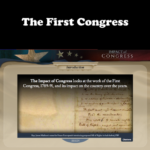In this lesson, students will learn about the powers of Congress, how they have evolved throughout history, and their impact on public policy. Students will view C-SPAN video clips to learn about the types of congressional power and apply that knowledge by developing strategies to improve the effectiveness of Congress.
District of Columbia Compensated Emancipation Act of 1862
The 150th anniversary of the District of Columbia Compensated Emancipation Act of 1862
occurred in 2012. This bill was introduced to Congress to end slavery in the District of
Columbia. Many citizens and members of Congress alike noted that the legality of slavery in
the District of Columbia was inconsistent with the ideals and aspirations of the nation. Congress
approved the bill, and President Abraham Lincoln signed the act.
This activity features the District of Columbia Compensated Emancipation Act of 1862 and
other primary and secondary sources that tell the story of Congress’s role in this first major step
toward the freeing of enslaved African Americans. While intended for 8th grade students, the
lesson can be adapted for other grade levels.
NHD Breaking Barriers: Americans and Native Americans
From the colonial era, relations between European settlers and Native American nations have been complicated. In 1803 Congress authorized and funded an expedition led by Meriwether Lewis and William Clark for exploration of the region and for better knowledge about American Indians of the Northwest in order to develop trade. About 30 years later, the United States forced the removal of Native Americans from their lands to make way for white American settlement. Congress and the president made treaties with Native American nations, but those treaties were not always respected as the United States continued to expand into the west. After Native Americans enlisted and served in both World War I and World War II, Congress passed legislation to begin to address longstanding Native Americans claims against the United States Government.
Congress by the Numbers
Together, the U.S. House of Representatives and U.S Senate are called Congress, the legislative branch of the federal government. Congress has many powers including writing the nation’s laws, approving treaties, and declaring war.
Congress Investigates – Virtual Exhibit
The power to investigate, implied by the U.S. Constitution, is one of Congress’s most important tools for developing effective public policy, conducting oversight, and informing the public. Congress has investigated issues throughout its history via formal investigations and fact-finding inquiries with wide-ranging results, often significantly affecting the history of the United States.
Enumerated and Implied Powers of Congress
This lesson has students learn about the concepts of enumerated and implied powers of Congress and explore real life examples of these powers. Students will use C-SPAN’s Constitution Clips resources to summarize the specific enumerated powers and identify the additional powers of Congress implied by them. This lesson works well in classes with one-to-one devices or could be adapted to fit a flipped classroom.
Conflict and Compromise – Virtual Exhibit
For more than two hundred years, the Capitol has been the place where representatives of the American people have debated how best to achieve the nation’s ideals. This exhibit displays some of our most important documents, drawn primarily from the collections of the Library of Congress and the National Archives, to illustrate the role of Congress in defining and helping to realize national goals and aspirations.
Congressional Power of Impeachment
In the Constitution, the Congress is given the sole power of impeachment and removing the President and all civil officers from office. This power of Legislative Branch provides a significant check over the Executive and Judicial Branches. This lesson provides explanations of the Constitutional basis of the power, the process for removing officials and the history of impeachments and removing these officials from office. It also provides discussions on the standards of impeachments and how those are interpreted by Congress.
Facts of Congress

Facts of Congress is a series of twenty fast-paced, one-minute animated videos that cover the basic concepts and terms of representative government. The series addresses questions such as: What is Congress? How does Congress work? What does Congress do for me? How can I participate? Scroll down on the linked page to find the full series of videos.
The Impact of Congress

The Impact of Congress looks at the work of the First Congress, 1789-91, and its impact on the country over the years. In this module you will learn about eleven of the First Congress’s most important accomplishments through primary source images and documents – accomplishments that still have a major impact on our country today. Then you will pick a later session of Congress and explore and analyze its accomplishments.